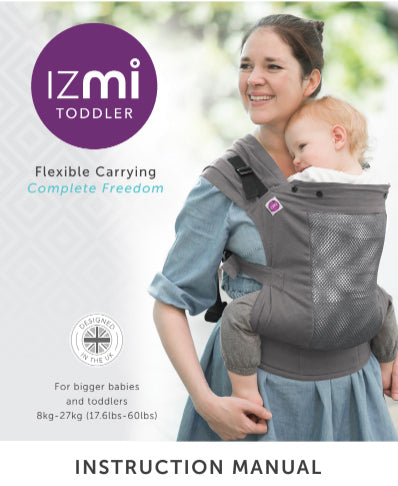How to use a baby carrier
Step-by-step instructions for Izmi Baby Carriers, Toddler Carriers and baby wraps.
It is important to adjust your Izmi tightly around your and your baby to prevent them from slumping, so that their airways are protected.
An Izmi that is snug and tightly fitted will support your baby’s spine and head, enabling them to relax. It will also keep your baby’s weight snugly held into you; this will make them feel lighter and will help prevent backache or sore shoulders.
Your baby should be held high and snug against your chest, close enough to kiss the top of their head; and with the carrier tightened to prevent them flopping or slumping away from your body.
If your baby
-feels heavy
-is pulling on your back/shoulders or
-moves lower on your body over time
-needs to be supported with one or two hands
Then you need to wear your Izmi higher and tighter on your body
To check for the perfect fit: briefly lean forwards slightly, with one hand supporting your baby’s head. If their tummy flops away from your chest, your Izmi needs to be tightened.
If you can’t comfortably take a deep breath: loosen your Izmi very slightly so it’s more comfortable for you.
Your wrap or carrier needs to be worn more tightly.
In a baby wrap: re-tie it ensuring it’s sufficiently snug and ensure you have tied a secure double knot. Here’s our video tutorial for how to correctly tie your wrap, for a perfect fit every time.
In an Izmi Baby or Toddler Carrier: Pop your hands under your baby’s bottom and cuddle them into you, as you would if you weren’t using a carrier. You’ll find you’re holding them higher up on your body. Reposition the waistband so it says under your baby’s bum and higher on your torso; then tighten the side straps so your baby is held snugly in place.
There is no fixed upper limit, so long as you are both comfortable. Just as there isn't an upper limit on how many hours a day you can spend cuddling and holding your baby, there's no real upper limit for how long you can spend carrying them.
In your baby’s first months, they may be happily carried for a large proportion of the day, coming out for feeds and nappy changes.
As they get older and they become more alert and awake for longer periods, they're going to be more keen to get down, explore on the floor and play and come up to you when they're tired and ready for a snuggle.




